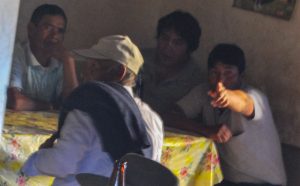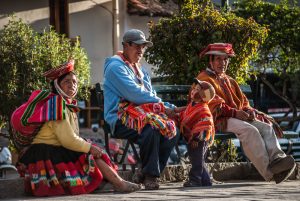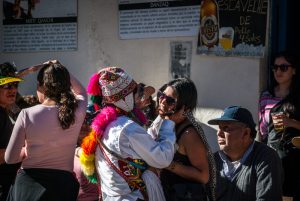A Word that Wounds, Ch’oto

The taught ball spurted forward, through the defense, and snagged in the net, a goal. As one team pumped the air amidst the dusty winds of an August afternoon on a plateau above Cuzco, the other started yelling at each other. “Why don’t you stay back? … If you had only done your job you would have blocked that. … Just shut the f’$#! up and let me play!”
The game was tense, as befits a quarterfinals match in a tournament. But while one team notably kept its cool, the other was an exaggeration of uptight, testosterone ridden, aggressive men who while driving down the street live on their horn and shout insults at every other driver with abandon.
Sunday soccer usually does not gets this tense, even though people play hard and passion rises. Afterwards, one of the players on the calmer team, the victorious one, told me that there was a “racial aspect” to the anger and personality of his opponents.
“When they play like that, filled with anger, we call them ch’otos”.
Ok. Even if I was surprised by the sudden tossing in of an argument that had racial implications, I had heard this word before.


One afternoon I visited the eminent Bolivian historian and anthropologist Max Portugal in La Paz, Bolivia’s Casa de la Cultura. From a window three floors above the street he decided to show me the full range of classifications stemming from the old Spanish caste system that were still relevant to life in La Paz. He would find someone, look at their mix of physical characteristics, dress, and movements and pronounce a classification, as is the city were made up of a range of types, from Black and Indian to White.
He said that the women who looked like their mothers and sisters had worn the broad flowing skirts of La Paz’s cholitas, but who wore inexpensive, knit pants, or a cheap dress were ch’otas. They had tried to cross the line from cholas to “gente decente”, decent folk.
Now the word suddenly broke the calm, like lightning on a sunny afternoon. “What does ch’ota mean to you?”
“They are people who just refuse to understand, even when you speak with them. They are aggressive and stubborn. They just do not get things.

“Another way to say it is that they are campechano. They may have their nice cars and think they are so well off, but they do not have education. They have not learned how to control themselves and respect people. They do not have manners.”
“So when you say they are campechano, you mean they are like people from rural communities, even though they have cars and other symbols of urban life? But didn’t you say team you are playing on is made up, with the exception of you, of people from a rural community?”
“Yes. But they have kept their politeness to each other, they have kept their culture and are good. The others think they are better but they are not good, they have lost their culture and on the field become like animals.’
“They are stubborn and dumb, like burros. They are asnu ch’otos, donkey ch’otos. Here ch’oto means their elongated snout, like a burro or a dog.
“They may think they are refined, but under pressure their Indian comes out.”
Although the light was still intense, illuminating shifting details of a mountains and valley, it just seemed we had moved in an unusual place.

People from rural communities often face a stigma in Cuzco. The elites have been known to use language to describe them as if they were little more than animals, as Margarita Huayhua notes in a recent article.
The word “Indian” is generally a negative word, since it carries these ideas of animal or brute, while the word people in farming communities use to describe themselves, runa, carries with it ideas of respect and mutual engagement.
The problem with the team needing anger management classes was not, per se, that they were a different race, but that they were people who had lost one culture (that of runas with solidarity and respect) and taken on where they seemed urbane and “decent” but carried an animal inside, an “Indian”.
Of course to some Peruvians this would be incomprehensible. How could they be runa and not Indian, since they were one and the same. But the argument used to describe the testy team requires these two be separated.
It might be useful to just look at some dictionary definitions of the word. Here it is hard, because like so many things in the Andes you are never completely sure where to look. Is the word of Spanish origin and so likely to be found in a Spanish dictionary? Or is it of indigenous origin and so something you should look for in a Quechua version?
If we assume it is Quechua and spelled like some variant of Ch’utu or chutu (by taking away the Spanish gender markers and making the vowels like those of Quechua) then, if in the verb form chutuy, it can mean to take of clothes, like the woman Max Jordan described who no longer wore a pollera. She was defined by the absence of a dress.
That same verb is used to take a pick axe and strike at the earth, what in English we would call “to pick” or “to pick at”.
It can also mean “to not have slept enough”. Or as a noun it can be the bump that arises after something strikes you.
Hum. This does seem to betting towards some of the actions of the offending team, angry, picking at each other with a pickaxe of words, and even perhaps raising blows, from landed elbows, feet and fists. But I am leery of this. It is too metaphoric and to really say there is a relationship would require listening to many native speakers use the word in many different contexts.

Nevertheless, let us also look at a Spanish dictionary. Here the Dictionary of the Royal Spanish Academy says that choto is a goat’s male kid while it is still nursing.
Oh my. Now we have moved into one of the rich sources of invective in the Spanish language, that of the male goat.
This is the cabrón that you will hear thrown with abandon in Mexican Spanish and is insulting in Peru. In fact around here the root of that word is so damning that people avoid it, by either making it feminine, i.e. cabra, or they use a euphemism, chivo.
The billy goat, even when a kid, is just unstable and demanding, capricious and a bit of a trickster. And it has those horns that speak of cuckholding and of the devil.
I do not know how these things come together to describe a kind of “racial” issue or a soccer team with an excess of temper. But together, the Quechua and the Spanish mark a set of meanings that seem to make sense.
That Indian, however, what about him? Well the Quechua dictionary says that chutu can also mean an Indian, or someone who looks bad or improper. But then when it pops out, it sounds a lot like the demon inside one, the devil who can make you do things.
Ch’oto continues to be an insult and it is filled with ethnic and racial distinctions, as well as a lot more. When those knees and tongues fly on the field next Sunday, it will still be there to make the competition even hotter.
Reference:
Margarita Huayhua, Racism and social interaction in a soutehrn Peruvian combi, Ethnic and Racial Studies, July 2013, 1-15, 2013.




